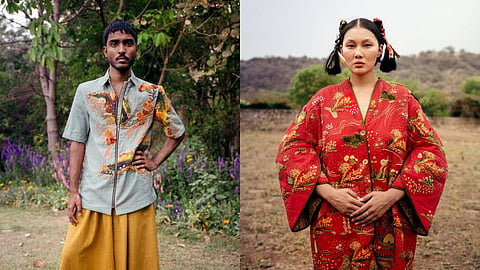
- HOMEGROWN WORLD
- #HGCREATORS
- #HGEXPLORE
- #HGVOICES
- #HGSHOP
- CAREERS
- ABOUT US
- CONTACT US

‘Katran’ translates in English to fabric scraps. In an Indian household, particularly where women operate their small businesses in sewing, these scraps are used in making everything from kitchen rags and doormats to coin purses and little dresses for the children’s dolls. Repurposing unused fabrics has been an essential part of our culture since the beginning. So even in a totally different area of dressmaking like high-fashion, this culture of upcycling still persists.
Not unlike Ankur Verma’s brainchild Til. The homegrown brand known for its bespoke pieces that uses extraordinary prints and embroidery techniques also revels in using ‘katran’ to create depth in its garments through patchwork. Transforming these remnants into intentional designs isn’t just a creative and cultural choice but a practice in ethical production and cyclical fashion. As a sustainable, slow fashion brand it highlights the brands commitment to keep their fabric waste to a minimum.
Founder Ankur Verma began his journey at NIFT, Kolkata with a specialization in leather. After having worked under Sabyasachi, the designer completed his Masters in Textiles from Domus Academy, Milan. He also spent time working with Armani’s senior designer, Carlos Oman and Bottega Veneta developing the sensibilities that’d allow him to translate indigenous Indian craftsmanship into contemporary imagery in a balanced way.
Til’s collections, each with its own distinct Identity and visual language, boast loud prints and unique embroidery techniques that still come across as understated and elegant. The brand uses homegrown fabrics such as khadi, silk, crushed cotton and even blends like cotton silk satin as the canvas to showcase its handloom, artisanal embroidery, graphic prints and crafted patchworks. Their silhouettes range from Roman skirt-like uniforms and Scottish kilts, to draped pants derived from the outlines of pajamas to the layers of cardigan-over-a-kurta that we see across the subcontinent in the winters. Whether it’s hand-painted designs that are digitally printed over co-ords to create a bold, maximalist outfit, or seemingly impossible embroidery marvels that replicate brushstrokes, as well as 3D textures that feel luxurious to the touch, Til has perfected the sublime art of statement clothing. The fact that the brand has dressed artists like Diljeet Dosanjh and Faraz Ansari is a testament to the space it has come to occupy in the zeitgeist.
Til, through its impeccable craftsmanship and expansive vision evokes a desire fashion enthusiasts share.. The adulation we give to fashion houses far removed from everything that represents our culture is better projected towards homegrown brands like Til that maintain the same sophistication while being rooted in the heritage of Indian handicrafts.
You can follow Til here.
If you enjoyed reading this, here's more from Homegrown:
RAFU'D Latest Collection Channels The Artistic & Spiritual Essence Of Pichvai Art
Next-Gen Homegrown Labels On Our Radar Intersecting Sustainability & Cultural Narratives
Surmeyi's Mindful Jewellery and Lifestyle Products Evoke A Sense of Belonging
